Evaluation of the Sarbanes-Oxley Act in Reducing Accounting Fraud
VerifiedAdded on 2020/03/23
|24
|7015
|190
Report
AI Summary
This report critically assesses the effectiveness of the 2002 Sarbanes-Oxley Act (SOX) in reducing accounting fraud. The study investigates SOX's impact on internal controls, financial reporting, and fraud detection across three companies: American International Group (AIG), Enron, and Waste Management. Utilizing a qualitative research methodology, the report analyzes secondary data to evaluate the act's influence on corporate governance and the role of whistleblowers in preventing fraudulent activities. The findings indicate that SOX has improved internal control procedures and auditing, contributing to a reduction in fraud. However, the report also acknowledges the limitations of SOX, such as the potential for management override and the costs associated with compliance. Recommendations include the importance of proactive fraud detection measures and the need for continuous improvements in financial reporting practices. The report concludes by emphasizing the ongoing need for vigilance and robust internal controls to maintain corporate integrity.

Assignment 2
Paraphrase This Document
Need a fresh take? Get an instant paraphrase of this document with our AI Paraphraser
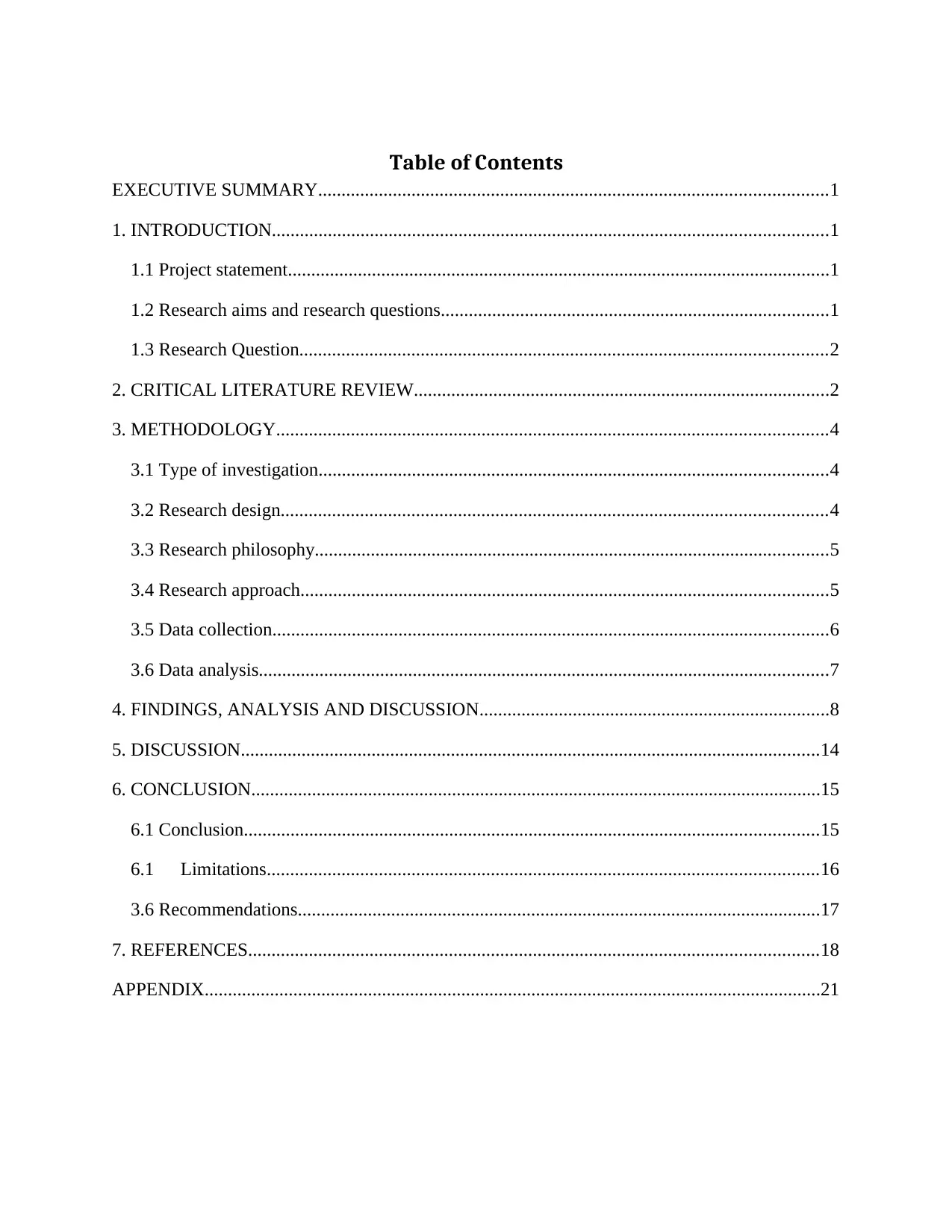
Table of Contents
EXECUTIVE SUMMARY.............................................................................................................1
1. INTRODUCTION.......................................................................................................................1
1.1 Project statement....................................................................................................................1
1.2 Research aims and research questions...................................................................................1
1.3 Research Question.................................................................................................................2
2. CRITICAL LITERATURE REVIEW.........................................................................................2
3. METHODOLOGY......................................................................................................................4
3.1 Type of investigation.............................................................................................................4
3.2 Research design.....................................................................................................................4
3.3 Research philosophy..............................................................................................................5
3.4 Research approach.................................................................................................................5
3.5 Data collection.......................................................................................................................6
3.6 Data analysis..........................................................................................................................7
4. FINDINGS, ANALYSIS AND DISCUSSION...........................................................................8
5. DISCUSSION............................................................................................................................14
6. CONCLUSION..........................................................................................................................15
6.1 Conclusion...........................................................................................................................15
6.1 Limitations......................................................................................................................16
3.6 Recommendations................................................................................................................17
7. REFERENCES..........................................................................................................................18
APPENDIX....................................................................................................................................21
EXECUTIVE SUMMARY.............................................................................................................1
1. INTRODUCTION.......................................................................................................................1
1.1 Project statement....................................................................................................................1
1.2 Research aims and research questions...................................................................................1
1.3 Research Question.................................................................................................................2
2. CRITICAL LITERATURE REVIEW.........................................................................................2
3. METHODOLOGY......................................................................................................................4
3.1 Type of investigation.............................................................................................................4
3.2 Research design.....................................................................................................................4
3.3 Research philosophy..............................................................................................................5
3.4 Research approach.................................................................................................................5
3.5 Data collection.......................................................................................................................6
3.6 Data analysis..........................................................................................................................7
4. FINDINGS, ANALYSIS AND DISCUSSION...........................................................................8
5. DISCUSSION............................................................................................................................14
6. CONCLUSION..........................................................................................................................15
6.1 Conclusion...........................................................................................................................15
6.1 Limitations......................................................................................................................16
3.6 Recommendations................................................................................................................17
7. REFERENCES..........................................................................................................................18
APPENDIX....................................................................................................................................21
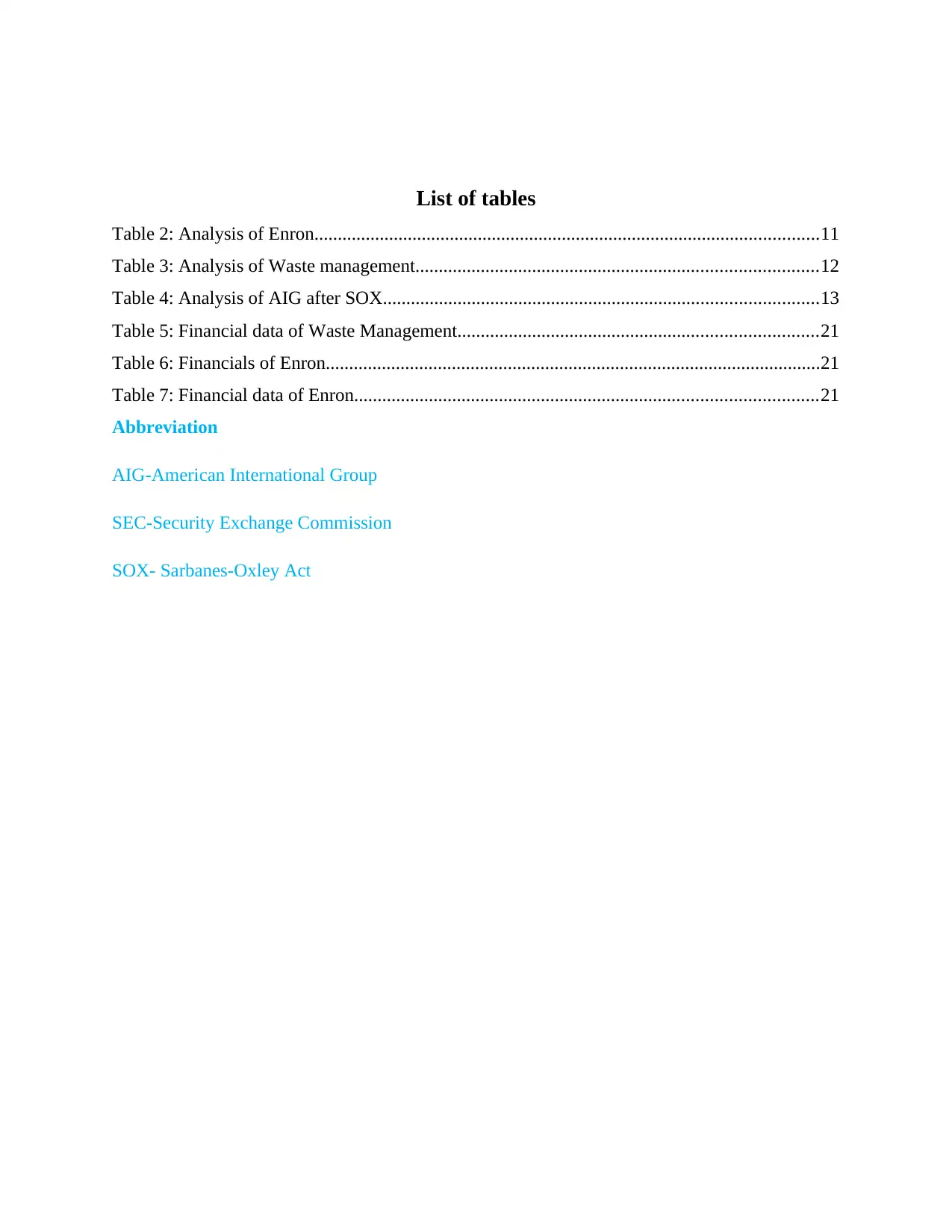
List of tables
Table 2: Analysis of Enron............................................................................................................11
Table 3: Analysis of Waste management......................................................................................12
Table 4: Analysis of AIG after SOX.............................................................................................13
Table 5: Financial data of Waste Management.............................................................................21
Table 6: Financials of Enron..........................................................................................................21
Table 7: Financial data of Enron...................................................................................................21
Abbreviation
AIG-American International Group
SEC-Security Exchange Commission
SOX- Sarbanes-Oxley Act
Table 2: Analysis of Enron............................................................................................................11
Table 3: Analysis of Waste management......................................................................................12
Table 4: Analysis of AIG after SOX.............................................................................................13
Table 5: Financial data of Waste Management.............................................................................21
Table 6: Financials of Enron..........................................................................................................21
Table 7: Financial data of Enron...................................................................................................21
Abbreviation
AIG-American International Group
SEC-Security Exchange Commission
SOX- Sarbanes-Oxley Act
⊘ This is a preview!⊘
Do you want full access?
Subscribe today to unlock all pages.

Trusted by 1+ million students worldwide
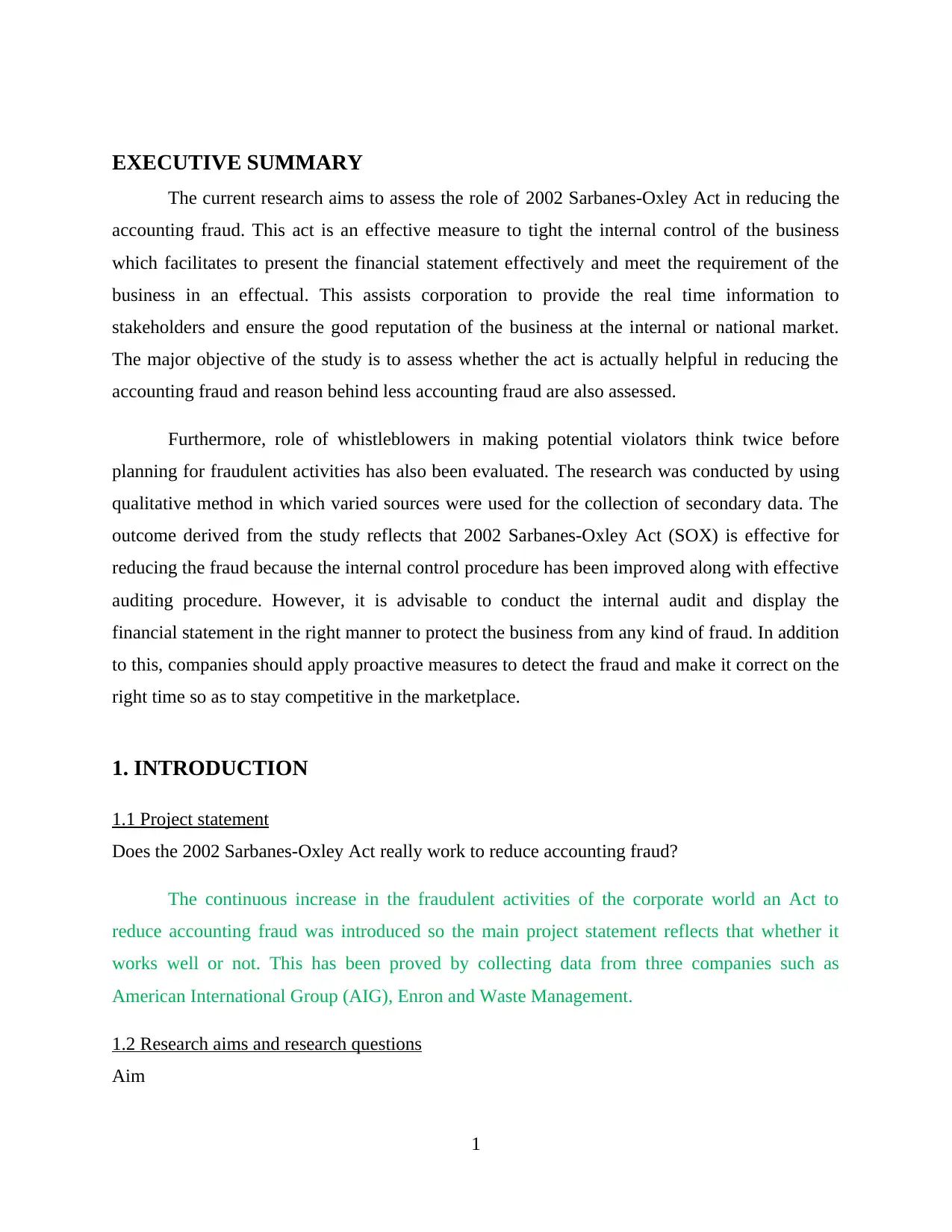
EXECUTIVE SUMMARY
The current research aims to assess the role of 2002 Sarbanes-Oxley Act in reducing the
accounting fraud. This act is an effective measure to tight the internal control of the business
which facilitates to present the financial statement effectively and meet the requirement of the
business in an effectual. This assists corporation to provide the real time information to
stakeholders and ensure the good reputation of the business at the internal or national market.
The major objective of the study is to assess whether the act is actually helpful in reducing the
accounting fraud and reason behind less accounting fraud are also assessed.
Furthermore, role of whistleblowers in making potential violators think twice before
planning for fraudulent activities has also been evaluated. The research was conducted by using
qualitative method in which varied sources were used for the collection of secondary data. The
outcome derived from the study reflects that 2002 Sarbanes-Oxley Act (SOX) is effective for
reducing the fraud because the internal control procedure has been improved along with effective
auditing procedure. However, it is advisable to conduct the internal audit and display the
financial statement in the right manner to protect the business from any kind of fraud. In addition
to this, companies should apply proactive measures to detect the fraud and make it correct on the
right time so as to stay competitive in the marketplace.
1. INTRODUCTION
1.1 Project statement
Does the 2002 Sarbanes-Oxley Act really work to reduce accounting fraud?
The continuous increase in the fraudulent activities of the corporate world an Act to
reduce accounting fraud was introduced so the main project statement reflects that whether it
works well or not. This has been proved by collecting data from three companies such as
American International Group (AIG), Enron and Waste Management.
1.2 Research aims and research questions
Aim
1
The current research aims to assess the role of 2002 Sarbanes-Oxley Act in reducing the
accounting fraud. This act is an effective measure to tight the internal control of the business
which facilitates to present the financial statement effectively and meet the requirement of the
business in an effectual. This assists corporation to provide the real time information to
stakeholders and ensure the good reputation of the business at the internal or national market.
The major objective of the study is to assess whether the act is actually helpful in reducing the
accounting fraud and reason behind less accounting fraud are also assessed.
Furthermore, role of whistleblowers in making potential violators think twice before
planning for fraudulent activities has also been evaluated. The research was conducted by using
qualitative method in which varied sources were used for the collection of secondary data. The
outcome derived from the study reflects that 2002 Sarbanes-Oxley Act (SOX) is effective for
reducing the fraud because the internal control procedure has been improved along with effective
auditing procedure. However, it is advisable to conduct the internal audit and display the
financial statement in the right manner to protect the business from any kind of fraud. In addition
to this, companies should apply proactive measures to detect the fraud and make it correct on the
right time so as to stay competitive in the marketplace.
1. INTRODUCTION
1.1 Project statement
Does the 2002 Sarbanes-Oxley Act really work to reduce accounting fraud?
The continuous increase in the fraudulent activities of the corporate world an Act to
reduce accounting fraud was introduced so the main project statement reflects that whether it
works well or not. This has been proved by collecting data from three companies such as
American International Group (AIG), Enron and Waste Management.
1.2 Research aims and research questions
Aim
1
Paraphrase This Document
Need a fresh take? Get an instant paraphrase of this document with our AI Paraphraser
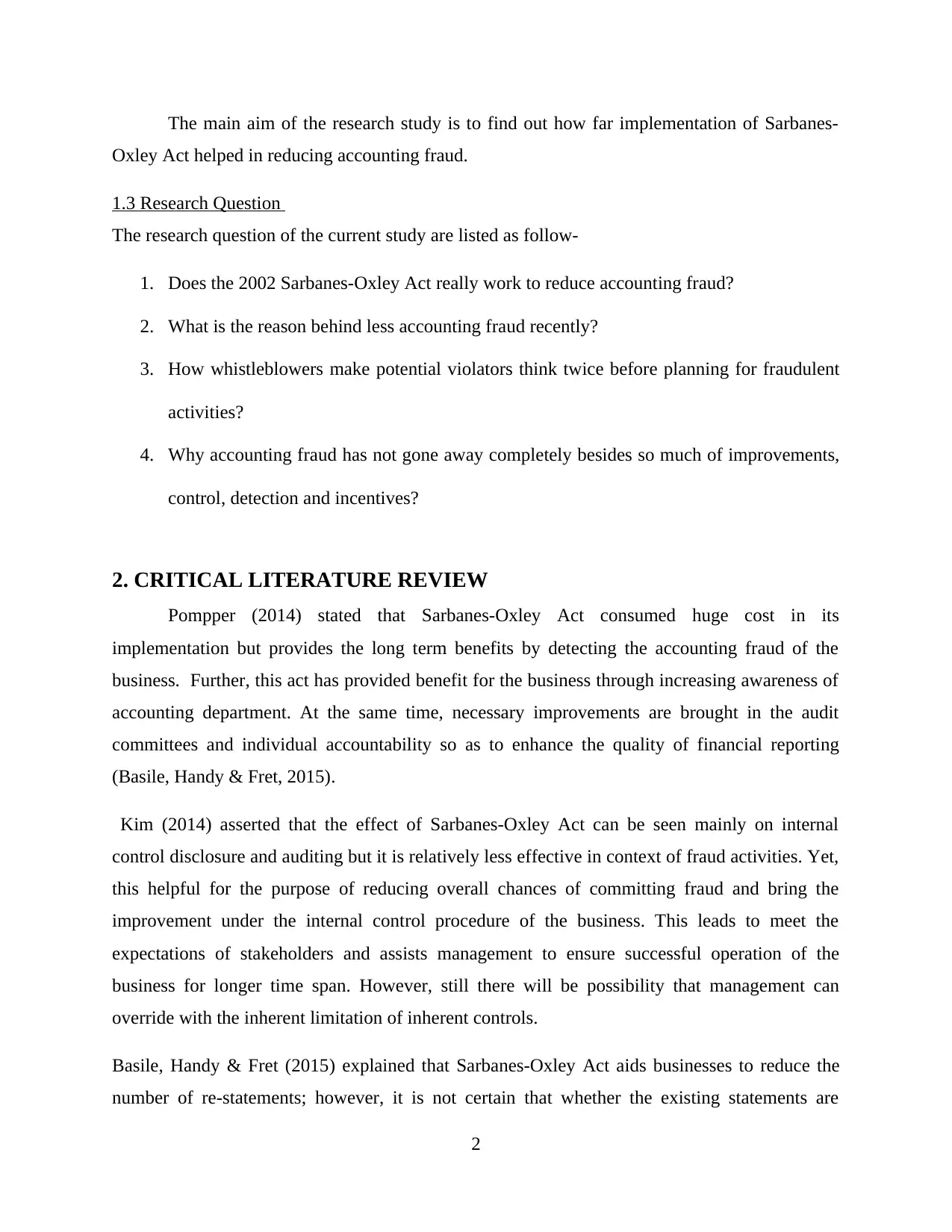
The main aim of the research study is to find out how far implementation of Sarbanes-
Oxley Act helped in reducing accounting fraud.
1.3 Research Question
The research question of the current study are listed as follow-
1. Does the 2002 Sarbanes-Oxley Act really work to reduce accounting fraud?
2. What is the reason behind less accounting fraud recently?
3. How whistleblowers make potential violators think twice before planning for fraudulent
activities?
4. Why accounting fraud has not gone away completely besides so much of improvements,
control, detection and incentives?
2. CRITICAL LITERATURE REVIEW
Pompper (2014) stated that Sarbanes-Oxley Act consumed huge cost in its
implementation but provides the long term benefits by detecting the accounting fraud of the
business. Further, this act has provided benefit for the business through increasing awareness of
accounting department. At the same time, necessary improvements are brought in the audit
committees and individual accountability so as to enhance the quality of financial reporting
(Basile, Handy & Fret, 2015).
Kim (2014) asserted that the effect of Sarbanes-Oxley Act can be seen mainly on internal
control disclosure and auditing but it is relatively less effective in context of fraud activities. Yet,
this helpful for the purpose of reducing overall chances of committing fraud and bring the
improvement under the internal control procedure of the business. This leads to meet the
expectations of stakeholders and assists management to ensure successful operation of the
business for longer time span. However, still there will be possibility that management can
override with the inherent limitation of inherent controls.
Basile, Handy & Fret (2015) explained that Sarbanes-Oxley Act aids businesses to reduce the
number of re-statements; however, it is not certain that whether the existing statements are
2
Oxley Act helped in reducing accounting fraud.
1.3 Research Question
The research question of the current study are listed as follow-
1. Does the 2002 Sarbanes-Oxley Act really work to reduce accounting fraud?
2. What is the reason behind less accounting fraud recently?
3. How whistleblowers make potential violators think twice before planning for fraudulent
activities?
4. Why accounting fraud has not gone away completely besides so much of improvements,
control, detection and incentives?
2. CRITICAL LITERATURE REVIEW
Pompper (2014) stated that Sarbanes-Oxley Act consumed huge cost in its
implementation but provides the long term benefits by detecting the accounting fraud of the
business. Further, this act has provided benefit for the business through increasing awareness of
accounting department. At the same time, necessary improvements are brought in the audit
committees and individual accountability so as to enhance the quality of financial reporting
(Basile, Handy & Fret, 2015).
Kim (2014) asserted that the effect of Sarbanes-Oxley Act can be seen mainly on internal
control disclosure and auditing but it is relatively less effective in context of fraud activities. Yet,
this helpful for the purpose of reducing overall chances of committing fraud and bring the
improvement under the internal control procedure of the business. This leads to meet the
expectations of stakeholders and assists management to ensure successful operation of the
business for longer time span. However, still there will be possibility that management can
override with the inherent limitation of inherent controls.
Basile, Handy & Fret (2015) explained that Sarbanes-Oxley Act aids businesses to reduce the
number of re-statements; however, it is not certain that whether the existing statements are
2
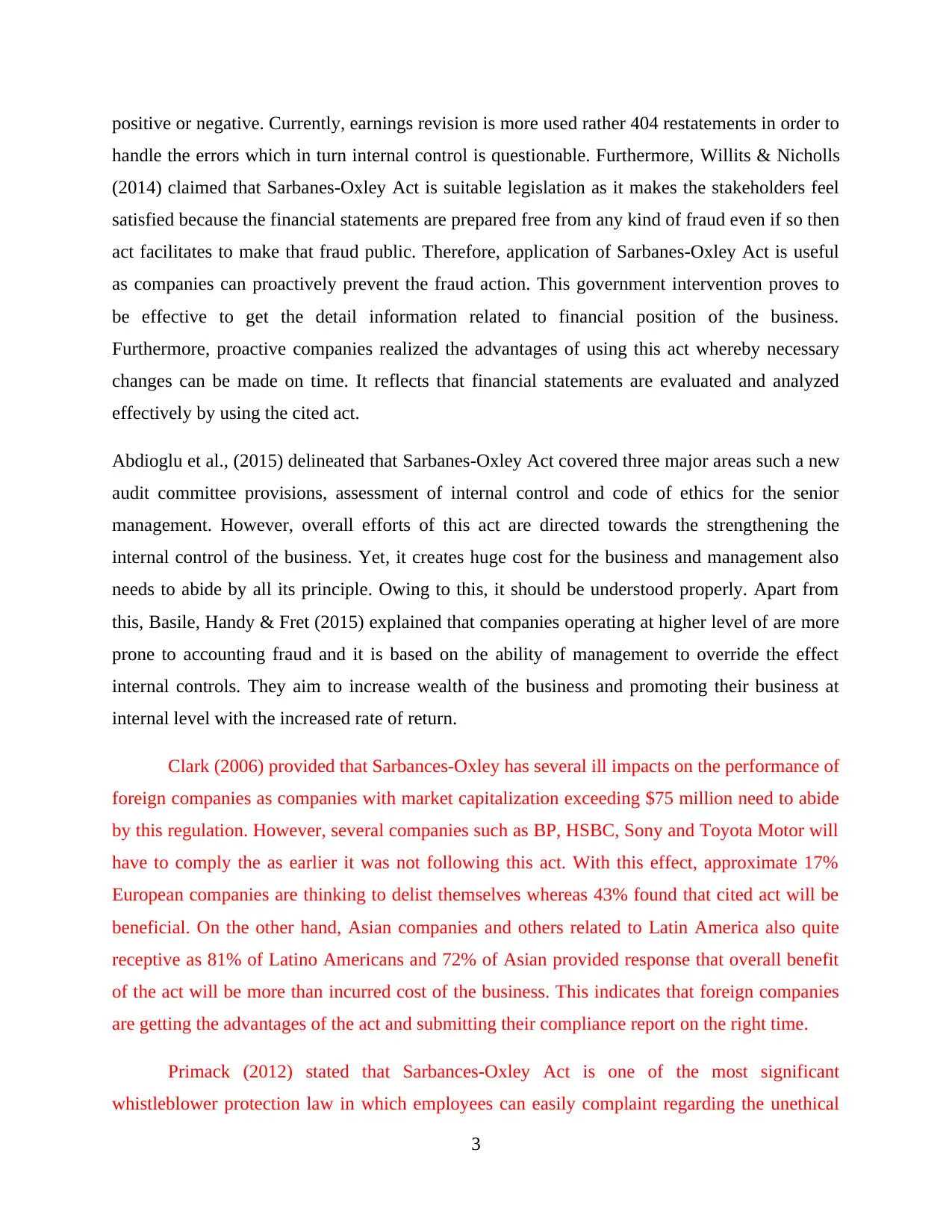
positive or negative. Currently, earnings revision is more used rather 404 restatements in order to
handle the errors which in turn internal control is questionable. Furthermore, Willits & Nicholls
(2014) claimed that Sarbanes-Oxley Act is suitable legislation as it makes the stakeholders feel
satisfied because the financial statements are prepared free from any kind of fraud even if so then
act facilitates to make that fraud public. Therefore, application of Sarbanes-Oxley Act is useful
as companies can proactively prevent the fraud action. This government intervention proves to
be effective to get the detail information related to financial position of the business.
Furthermore, proactive companies realized the advantages of using this act whereby necessary
changes can be made on time. It reflects that financial statements are evaluated and analyzed
effectively by using the cited act.
Abdioglu et al., (2015) delineated that Sarbanes-Oxley Act covered three major areas such a new
audit committee provisions, assessment of internal control and code of ethics for the senior
management. However, overall efforts of this act are directed towards the strengthening the
internal control of the business. Yet, it creates huge cost for the business and management also
needs to abide by all its principle. Owing to this, it should be understood properly. Apart from
this, Basile, Handy & Fret (2015) explained that companies operating at higher level of are more
prone to accounting fraud and it is based on the ability of management to override the effect
internal controls. They aim to increase wealth of the business and promoting their business at
internal level with the increased rate of return.
Clark (2006) provided that Sarbances-Oxley has several ill impacts on the performance of
foreign companies as companies with market capitalization exceeding $75 million need to abide
by this regulation. However, several companies such as BP, HSBC, Sony and Toyota Motor will
have to comply the as earlier it was not following this act. With this effect, approximate 17%
European companies are thinking to delist themselves whereas 43% found that cited act will be
beneficial. On the other hand, Asian companies and others related to Latin America also quite
receptive as 81% of Latino Americans and 72% of Asian provided response that overall benefit
of the act will be more than incurred cost of the business. This indicates that foreign companies
are getting the advantages of the act and submitting their compliance report on the right time.
Primack (2012) stated that Sarbances-Oxley Act is one of the most significant
whistleblower protection law in which employees can easily complaint regarding the unethical
3
handle the errors which in turn internal control is questionable. Furthermore, Willits & Nicholls
(2014) claimed that Sarbanes-Oxley Act is suitable legislation as it makes the stakeholders feel
satisfied because the financial statements are prepared free from any kind of fraud even if so then
act facilitates to make that fraud public. Therefore, application of Sarbanes-Oxley Act is useful
as companies can proactively prevent the fraud action. This government intervention proves to
be effective to get the detail information related to financial position of the business.
Furthermore, proactive companies realized the advantages of using this act whereby necessary
changes can be made on time. It reflects that financial statements are evaluated and analyzed
effectively by using the cited act.
Abdioglu et al., (2015) delineated that Sarbanes-Oxley Act covered three major areas such a new
audit committee provisions, assessment of internal control and code of ethics for the senior
management. However, overall efforts of this act are directed towards the strengthening the
internal control of the business. Yet, it creates huge cost for the business and management also
needs to abide by all its principle. Owing to this, it should be understood properly. Apart from
this, Basile, Handy & Fret (2015) explained that companies operating at higher level of are more
prone to accounting fraud and it is based on the ability of management to override the effect
internal controls. They aim to increase wealth of the business and promoting their business at
internal level with the increased rate of return.
Clark (2006) provided that Sarbances-Oxley has several ill impacts on the performance of
foreign companies as companies with market capitalization exceeding $75 million need to abide
by this regulation. However, several companies such as BP, HSBC, Sony and Toyota Motor will
have to comply the as earlier it was not following this act. With this effect, approximate 17%
European companies are thinking to delist themselves whereas 43% found that cited act will be
beneficial. On the other hand, Asian companies and others related to Latin America also quite
receptive as 81% of Latino Americans and 72% of Asian provided response that overall benefit
of the act will be more than incurred cost of the business. This indicates that foreign companies
are getting the advantages of the act and submitting their compliance report on the right time.
Primack (2012) stated that Sarbances-Oxley Act is one of the most significant
whistleblower protection law in which employees can easily complaint regarding the unethical
3
⊘ This is a preview!⊘
Do you want full access?
Subscribe today to unlock all pages.

Trusted by 1+ million students worldwide
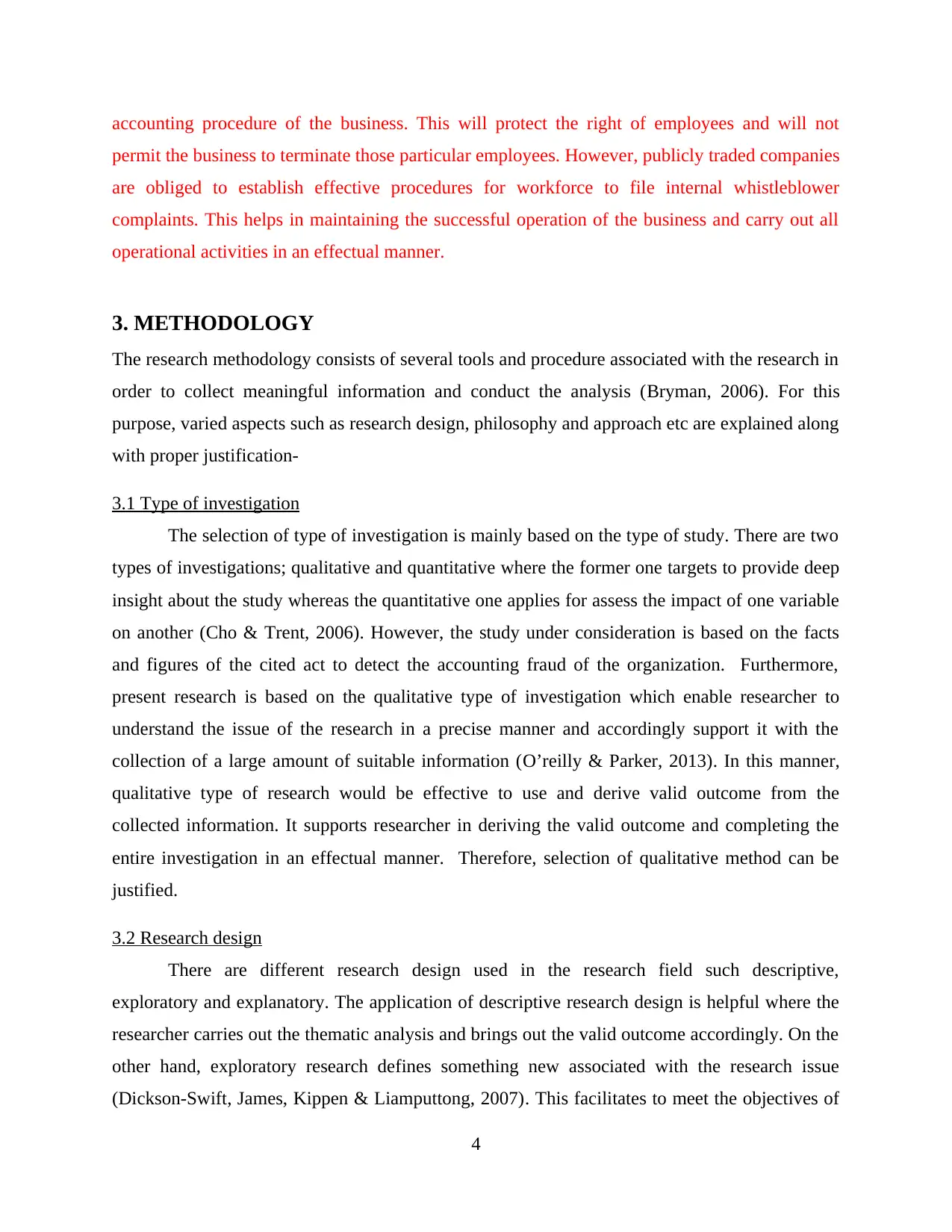
accounting procedure of the business. This will protect the right of employees and will not
permit the business to terminate those particular employees. However, publicly traded companies
are obliged to establish effective procedures for workforce to file internal whistleblower
complaints. This helps in maintaining the successful operation of the business and carry out all
operational activities in an effectual manner.
3. METHODOLOGY
The research methodology consists of several tools and procedure associated with the research in
order to collect meaningful information and conduct the analysis (Bryman, 2006). For this
purpose, varied aspects such as research design, philosophy and approach etc are explained along
with proper justification-
3.1 Type of investigation
The selection of type of investigation is mainly based on the type of study. There are two
types of investigations; qualitative and quantitative where the former one targets to provide deep
insight about the study whereas the quantitative one applies for assess the impact of one variable
on another (Cho & Trent, 2006). However, the study under consideration is based on the facts
and figures of the cited act to detect the accounting fraud of the organization. Furthermore,
present research is based on the qualitative type of investigation which enable researcher to
understand the issue of the research in a precise manner and accordingly support it with the
collection of a large amount of suitable information (O’reilly & Parker, 2013). In this manner,
qualitative type of research would be effective to use and derive valid outcome from the
collected information. It supports researcher in deriving the valid outcome and completing the
entire investigation in an effectual manner. Therefore, selection of qualitative method can be
justified.
3.2 Research design
There are different research design used in the research field such descriptive,
exploratory and explanatory. The application of descriptive research design is helpful where the
researcher carries out the thematic analysis and brings out the valid outcome accordingly. On the
other hand, exploratory research defines something new associated with the research issue
(Dickson-Swift, James, Kippen & Liamputtong, 2007). This facilitates to meet the objectives of
4
permit the business to terminate those particular employees. However, publicly traded companies
are obliged to establish effective procedures for workforce to file internal whistleblower
complaints. This helps in maintaining the successful operation of the business and carry out all
operational activities in an effectual manner.
3. METHODOLOGY
The research methodology consists of several tools and procedure associated with the research in
order to collect meaningful information and conduct the analysis (Bryman, 2006). For this
purpose, varied aspects such as research design, philosophy and approach etc are explained along
with proper justification-
3.1 Type of investigation
The selection of type of investigation is mainly based on the type of study. There are two
types of investigations; qualitative and quantitative where the former one targets to provide deep
insight about the study whereas the quantitative one applies for assess the impact of one variable
on another (Cho & Trent, 2006). However, the study under consideration is based on the facts
and figures of the cited act to detect the accounting fraud of the organization. Furthermore,
present research is based on the qualitative type of investigation which enable researcher to
understand the issue of the research in a precise manner and accordingly support it with the
collection of a large amount of suitable information (O’reilly & Parker, 2013). In this manner,
qualitative type of research would be effective to use and derive valid outcome from the
collected information. It supports researcher in deriving the valid outcome and completing the
entire investigation in an effectual manner. Therefore, selection of qualitative method can be
justified.
3.2 Research design
There are different research design used in the research field such descriptive,
exploratory and explanatory. The application of descriptive research design is helpful where the
researcher carries out the thematic analysis and brings out the valid outcome accordingly. On the
other hand, exploratory research defines something new associated with the research issue
(Dickson-Swift, James, Kippen & Liamputtong, 2007). This facilitates to meet the objectives of
4
Paraphrase This Document
Need a fresh take? Get an instant paraphrase of this document with our AI Paraphraser
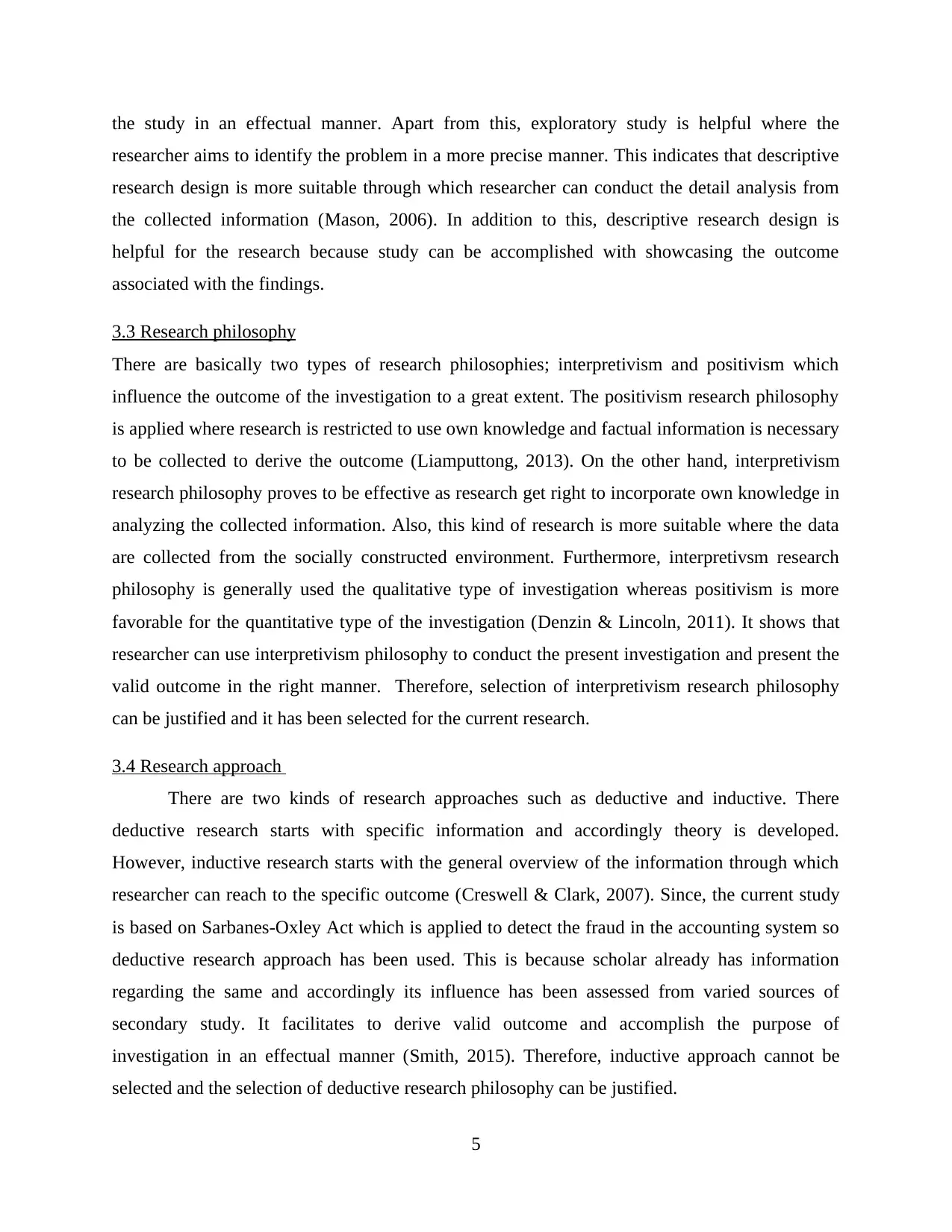
the study in an effectual manner. Apart from this, exploratory study is helpful where the
researcher aims to identify the problem in a more precise manner. This indicates that descriptive
research design is more suitable through which researcher can conduct the detail analysis from
the collected information (Mason, 2006). In addition to this, descriptive research design is
helpful for the research because study can be accomplished with showcasing the outcome
associated with the findings.
3.3 Research philosophy
There are basically two types of research philosophies; interpretivism and positivism which
influence the outcome of the investigation to a great extent. The positivism research philosophy
is applied where research is restricted to use own knowledge and factual information is necessary
to be collected to derive the outcome (Liamputtong, 2013). On the other hand, interpretivism
research philosophy proves to be effective as research get right to incorporate own knowledge in
analyzing the collected information. Also, this kind of research is more suitable where the data
are collected from the socially constructed environment. Furthermore, interpretivsm research
philosophy is generally used the qualitative type of investigation whereas positivism is more
favorable for the quantitative type of the investigation (Denzin & Lincoln, 2011). It shows that
researcher can use interpretivism philosophy to conduct the present investigation and present the
valid outcome in the right manner. Therefore, selection of interpretivism research philosophy
can be justified and it has been selected for the current research.
3.4 Research approach
There are two kinds of research approaches such as deductive and inductive. There
deductive research starts with specific information and accordingly theory is developed.
However, inductive research starts with the general overview of the information through which
researcher can reach to the specific outcome (Creswell & Clark, 2007). Since, the current study
is based on Sarbanes-Oxley Act which is applied to detect the fraud in the accounting system so
deductive research approach has been used. This is because scholar already has information
regarding the same and accordingly its influence has been assessed from varied sources of
secondary study. It facilitates to derive valid outcome and accomplish the purpose of
investigation in an effectual manner (Smith, 2015). Therefore, inductive approach cannot be
selected and the selection of deductive research philosophy can be justified.
5
researcher aims to identify the problem in a more precise manner. This indicates that descriptive
research design is more suitable through which researcher can conduct the detail analysis from
the collected information (Mason, 2006). In addition to this, descriptive research design is
helpful for the research because study can be accomplished with showcasing the outcome
associated with the findings.
3.3 Research philosophy
There are basically two types of research philosophies; interpretivism and positivism which
influence the outcome of the investigation to a great extent. The positivism research philosophy
is applied where research is restricted to use own knowledge and factual information is necessary
to be collected to derive the outcome (Liamputtong, 2013). On the other hand, interpretivism
research philosophy proves to be effective as research get right to incorporate own knowledge in
analyzing the collected information. Also, this kind of research is more suitable where the data
are collected from the socially constructed environment. Furthermore, interpretivsm research
philosophy is generally used the qualitative type of investigation whereas positivism is more
favorable for the quantitative type of the investigation (Denzin & Lincoln, 2011). It shows that
researcher can use interpretivism philosophy to conduct the present investigation and present the
valid outcome in the right manner. Therefore, selection of interpretivism research philosophy
can be justified and it has been selected for the current research.
3.4 Research approach
There are two kinds of research approaches such as deductive and inductive. There
deductive research starts with specific information and accordingly theory is developed.
However, inductive research starts with the general overview of the information through which
researcher can reach to the specific outcome (Creswell & Clark, 2007). Since, the current study
is based on Sarbanes-Oxley Act which is applied to detect the fraud in the accounting system so
deductive research approach has been used. This is because scholar already has information
regarding the same and accordingly its influence has been assessed from varied sources of
secondary study. It facilitates to derive valid outcome and accomplish the purpose of
investigation in an effectual manner (Smith, 2015). Therefore, inductive approach cannot be
selected and the selection of deductive research philosophy can be justified.
5
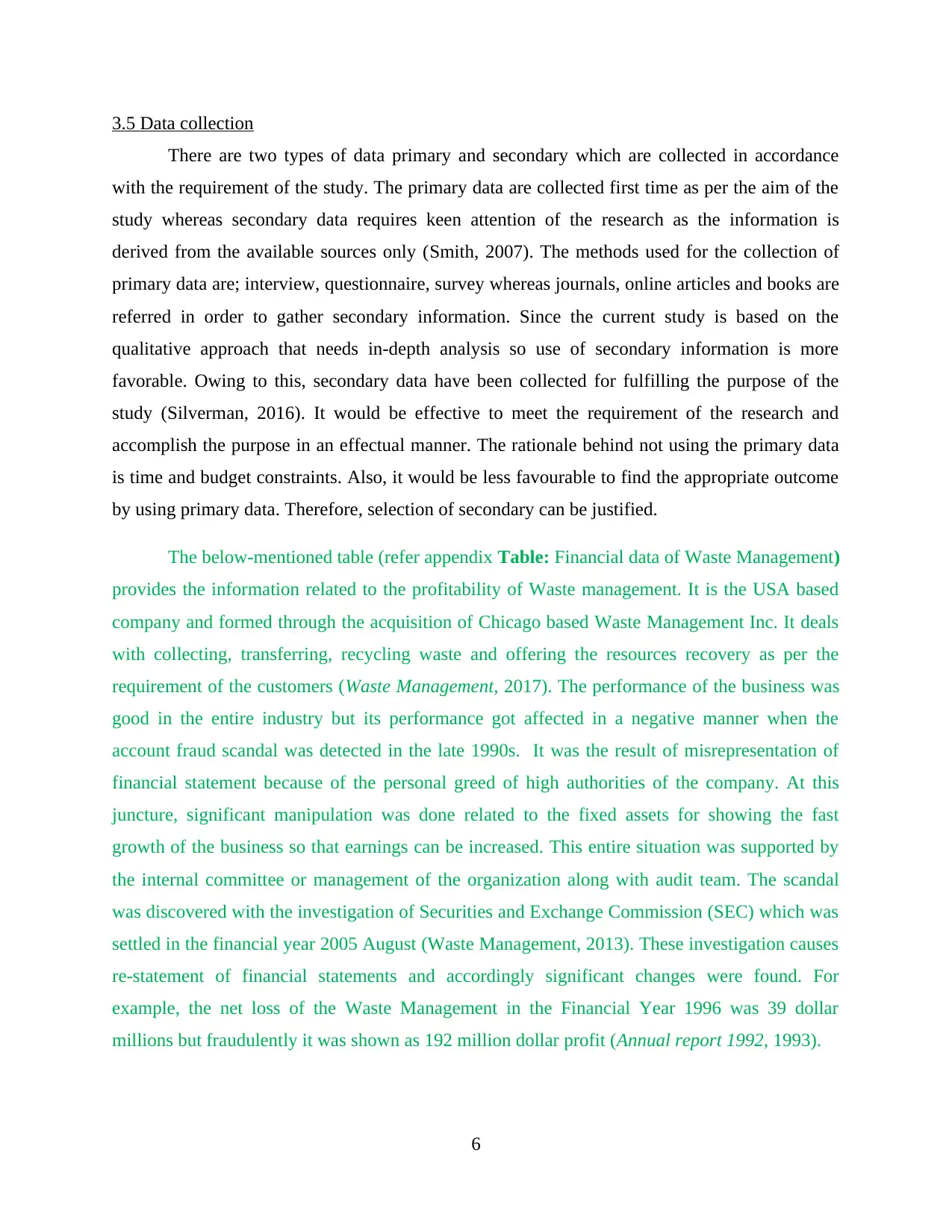
3.5 Data collection
There are two types of data primary and secondary which are collected in accordance
with the requirement of the study. The primary data are collected first time as per the aim of the
study whereas secondary data requires keen attention of the research as the information is
derived from the available sources only (Smith, 2007). The methods used for the collection of
primary data are; interview, questionnaire, survey whereas journals, online articles and books are
referred in order to gather secondary information. Since the current study is based on the
qualitative approach that needs in-depth analysis so use of secondary information is more
favorable. Owing to this, secondary data have been collected for fulfilling the purpose of the
study (Silverman, 2016). It would be effective to meet the requirement of the research and
accomplish the purpose in an effectual manner. The rationale behind not using the primary data
is time and budget constraints. Also, it would be less favourable to find the appropriate outcome
by using primary data. Therefore, selection of secondary can be justified.
The below-mentioned table (refer appendix Table: Financial data of Waste Management)
provides the information related to the profitability of Waste management. It is the USA based
company and formed through the acquisition of Chicago based Waste Management Inc. It deals
with collecting, transferring, recycling waste and offering the resources recovery as per the
requirement of the customers (Waste Management, 2017). The performance of the business was
good in the entire industry but its performance got affected in a negative manner when the
account fraud scandal was detected in the late 1990s. It was the result of misrepresentation of
financial statement because of the personal greed of high authorities of the company. At this
juncture, significant manipulation was done related to the fixed assets for showing the fast
growth of the business so that earnings can be increased. This entire situation was supported by
the internal committee or management of the organization along with audit team. The scandal
was discovered with the investigation of Securities and Exchange Commission (SEC) which was
settled in the financial year 2005 August (Waste Management, 2013). These investigation causes
re-statement of financial statements and accordingly significant changes were found. For
example, the net loss of the Waste Management in the Financial Year 1996 was 39 dollar
millions but fraudulently it was shown as 192 million dollar profit (Annual report 1992, 1993).
6
There are two types of data primary and secondary which are collected in accordance
with the requirement of the study. The primary data are collected first time as per the aim of the
study whereas secondary data requires keen attention of the research as the information is
derived from the available sources only (Smith, 2007). The methods used for the collection of
primary data are; interview, questionnaire, survey whereas journals, online articles and books are
referred in order to gather secondary information. Since the current study is based on the
qualitative approach that needs in-depth analysis so use of secondary information is more
favorable. Owing to this, secondary data have been collected for fulfilling the purpose of the
study (Silverman, 2016). It would be effective to meet the requirement of the research and
accomplish the purpose in an effectual manner. The rationale behind not using the primary data
is time and budget constraints. Also, it would be less favourable to find the appropriate outcome
by using primary data. Therefore, selection of secondary can be justified.
The below-mentioned table (refer appendix Table: Financial data of Waste Management)
provides the information related to the profitability of Waste management. It is the USA based
company and formed through the acquisition of Chicago based Waste Management Inc. It deals
with collecting, transferring, recycling waste and offering the resources recovery as per the
requirement of the customers (Waste Management, 2017). The performance of the business was
good in the entire industry but its performance got affected in a negative manner when the
account fraud scandal was detected in the late 1990s. It was the result of misrepresentation of
financial statement because of the personal greed of high authorities of the company. At this
juncture, significant manipulation was done related to the fixed assets for showing the fast
growth of the business so that earnings can be increased. This entire situation was supported by
the internal committee or management of the organization along with audit team. The scandal
was discovered with the investigation of Securities and Exchange Commission (SEC) which was
settled in the financial year 2005 August (Waste Management, 2013). These investigation causes
re-statement of financial statements and accordingly significant changes were found. For
example, the net loss of the Waste Management in the Financial Year 1996 was 39 dollar
millions but fraudulently it was shown as 192 million dollar profit (Annual report 1992, 1993).
6
⊘ This is a preview!⊘
Do you want full access?
Subscribe today to unlock all pages.

Trusted by 1+ million students worldwide
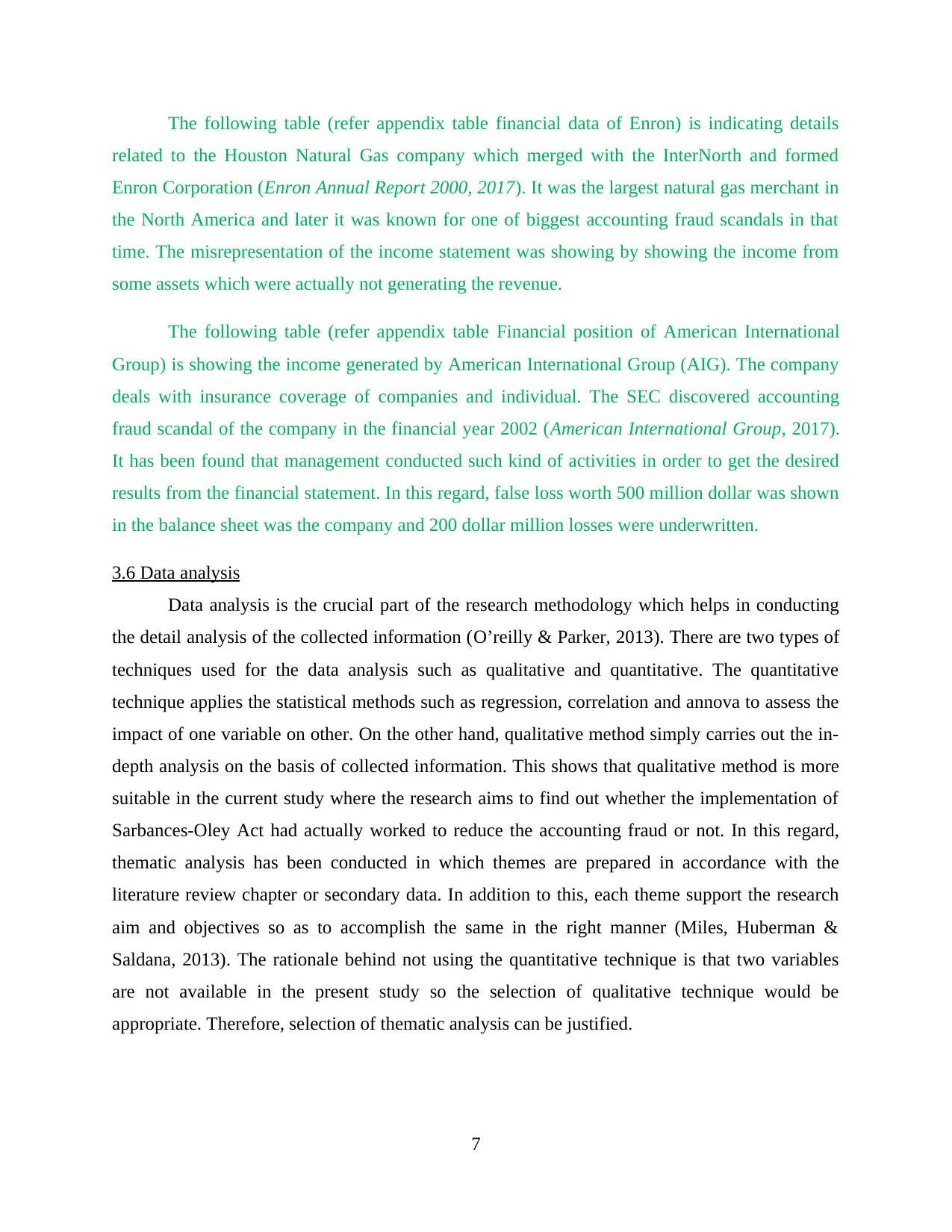
The following table (refer appendix table financial data of Enron) is indicating details
related to the Houston Natural Gas company which merged with the InterNorth and formed
Enron Corporation (Enron Annual Report 2000, 2017). It was the largest natural gas merchant in
the North America and later it was known for one of biggest accounting fraud scandals in that
time. The misrepresentation of the income statement was showing by showing the income from
some assets which were actually not generating the revenue.
The following table (refer appendix table Financial position of American International
Group) is showing the income generated by American International Group (AIG). The company
deals with insurance coverage of companies and individual. The SEC discovered accounting
fraud scandal of the company in the financial year 2002 (American International Group, 2017).
It has been found that management conducted such kind of activities in order to get the desired
results from the financial statement. In this regard, false loss worth 500 million dollar was shown
in the balance sheet was the company and 200 dollar million losses were underwritten.
3.6 Data analysis
Data analysis is the crucial part of the research methodology which helps in conducting
the detail analysis of the collected information (O’reilly & Parker, 2013). There are two types of
techniques used for the data analysis such as qualitative and quantitative. The quantitative
technique applies the statistical methods such as regression, correlation and annova to assess the
impact of one variable on other. On the other hand, qualitative method simply carries out the in-
depth analysis on the basis of collected information. This shows that qualitative method is more
suitable in the current study where the research aims to find out whether the implementation of
Sarbances-Oley Act had actually worked to reduce the accounting fraud or not. In this regard,
thematic analysis has been conducted in which themes are prepared in accordance with the
literature review chapter or secondary data. In addition to this, each theme support the research
aim and objectives so as to accomplish the same in the right manner (Miles, Huberman &
Saldana, 2013). The rationale behind not using the quantitative technique is that two variables
are not available in the present study so the selection of qualitative technique would be
appropriate. Therefore, selection of thematic analysis can be justified.
7
related to the Houston Natural Gas company which merged with the InterNorth and formed
Enron Corporation (Enron Annual Report 2000, 2017). It was the largest natural gas merchant in
the North America and later it was known for one of biggest accounting fraud scandals in that
time. The misrepresentation of the income statement was showing by showing the income from
some assets which were actually not generating the revenue.
The following table (refer appendix table Financial position of American International
Group) is showing the income generated by American International Group (AIG). The company
deals with insurance coverage of companies and individual. The SEC discovered accounting
fraud scandal of the company in the financial year 2002 (American International Group, 2017).
It has been found that management conducted such kind of activities in order to get the desired
results from the financial statement. In this regard, false loss worth 500 million dollar was shown
in the balance sheet was the company and 200 dollar million losses were underwritten.
3.6 Data analysis
Data analysis is the crucial part of the research methodology which helps in conducting
the detail analysis of the collected information (O’reilly & Parker, 2013). There are two types of
techniques used for the data analysis such as qualitative and quantitative. The quantitative
technique applies the statistical methods such as regression, correlation and annova to assess the
impact of one variable on other. On the other hand, qualitative method simply carries out the in-
depth analysis on the basis of collected information. This shows that qualitative method is more
suitable in the current study where the research aims to find out whether the implementation of
Sarbances-Oley Act had actually worked to reduce the accounting fraud or not. In this regard,
thematic analysis has been conducted in which themes are prepared in accordance with the
literature review chapter or secondary data. In addition to this, each theme support the research
aim and objectives so as to accomplish the same in the right manner (Miles, Huberman &
Saldana, 2013). The rationale behind not using the quantitative technique is that two variables
are not available in the present study so the selection of qualitative technique would be
appropriate. Therefore, selection of thematic analysis can be justified.
7
Paraphrase This Document
Need a fresh take? Get an instant paraphrase of this document with our AI Paraphraser
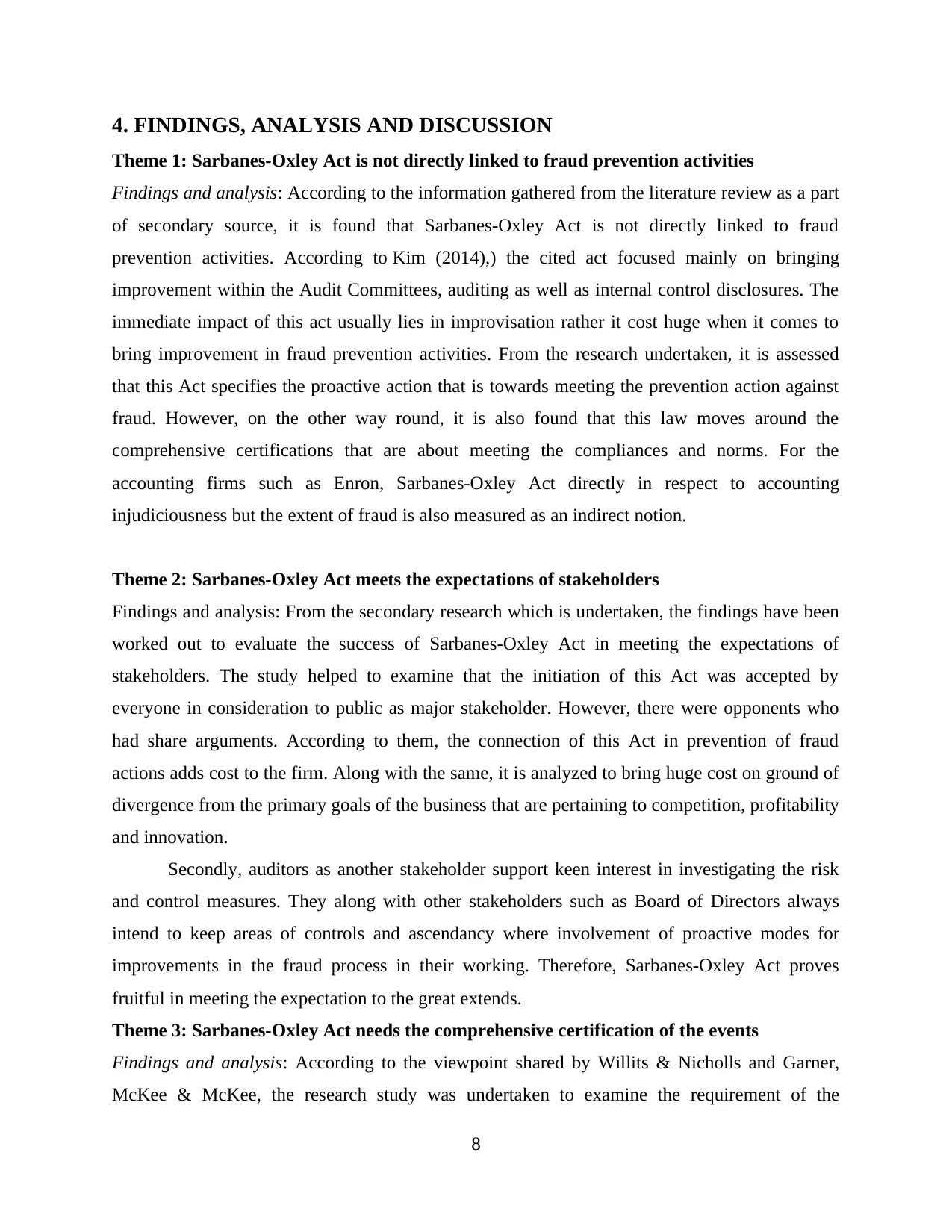
4. FINDINGS, ANALYSIS AND DISCUSSION
Theme 1: Sarbanes-Oxley Act is not directly linked to fraud prevention activities
Findings and analysis: According to the information gathered from the literature review as a part
of secondary source, it is found that Sarbanes-Oxley Act is not directly linked to fraud
prevention activities. According to Kim (2014),) the cited act focused mainly on bringing
improvement within the Audit Committees, auditing as well as internal control disclosures. The
immediate impact of this act usually lies in improvisation rather it cost huge when it comes to
bring improvement in fraud prevention activities. From the research undertaken, it is assessed
that this Act specifies the proactive action that is towards meeting the prevention action against
fraud. However, on the other way round, it is also found that this law moves around the
comprehensive certifications that are about meeting the compliances and norms. For the
accounting firms such as Enron, Sarbanes-Oxley Act directly in respect to accounting
injudiciousness but the extent of fraud is also measured as an indirect notion.
Theme 2: Sarbanes-Oxley Act meets the expectations of stakeholders
Findings and analysis: From the secondary research which is undertaken, the findings have been
worked out to evaluate the success of Sarbanes-Oxley Act in meeting the expectations of
stakeholders. The study helped to examine that the initiation of this Act was accepted by
everyone in consideration to public as major stakeholder. However, there were opponents who
had share arguments. According to them, the connection of this Act in prevention of fraud
actions adds cost to the firm. Along with the same, it is analyzed to bring huge cost on ground of
divergence from the primary goals of the business that are pertaining to competition, profitability
and innovation.
Secondly, auditors as another stakeholder support keen interest in investigating the risk
and control measures. They along with other stakeholders such as Board of Directors always
intend to keep areas of controls and ascendancy where involvement of proactive modes for
improvements in the fraud process in their working. Therefore, Sarbanes-Oxley Act proves
fruitful in meeting the expectation to the great extends.
Theme 3: Sarbanes-Oxley Act needs the comprehensive certification of the events
Findings and analysis: According to the viewpoint shared by Willits & Nicholls and Garner,
McKee & McKee, the research study was undertaken to examine the requirement of the
8
Theme 1: Sarbanes-Oxley Act is not directly linked to fraud prevention activities
Findings and analysis: According to the information gathered from the literature review as a part
of secondary source, it is found that Sarbanes-Oxley Act is not directly linked to fraud
prevention activities. According to Kim (2014),) the cited act focused mainly on bringing
improvement within the Audit Committees, auditing as well as internal control disclosures. The
immediate impact of this act usually lies in improvisation rather it cost huge when it comes to
bring improvement in fraud prevention activities. From the research undertaken, it is assessed
that this Act specifies the proactive action that is towards meeting the prevention action against
fraud. However, on the other way round, it is also found that this law moves around the
comprehensive certifications that are about meeting the compliances and norms. For the
accounting firms such as Enron, Sarbanes-Oxley Act directly in respect to accounting
injudiciousness but the extent of fraud is also measured as an indirect notion.
Theme 2: Sarbanes-Oxley Act meets the expectations of stakeholders
Findings and analysis: From the secondary research which is undertaken, the findings have been
worked out to evaluate the success of Sarbanes-Oxley Act in meeting the expectations of
stakeholders. The study helped to examine that the initiation of this Act was accepted by
everyone in consideration to public as major stakeholder. However, there were opponents who
had share arguments. According to them, the connection of this Act in prevention of fraud
actions adds cost to the firm. Along with the same, it is analyzed to bring huge cost on ground of
divergence from the primary goals of the business that are pertaining to competition, profitability
and innovation.
Secondly, auditors as another stakeholder support keen interest in investigating the risk
and control measures. They along with other stakeholders such as Board of Directors always
intend to keep areas of controls and ascendancy where involvement of proactive modes for
improvements in the fraud process in their working. Therefore, Sarbanes-Oxley Act proves
fruitful in meeting the expectation to the great extends.
Theme 3: Sarbanes-Oxley Act needs the comprehensive certification of the events
Findings and analysis: According to the viewpoint shared by Willits & Nicholls and Garner,
McKee & McKee, the research study was undertaken to examine the requirement of the
8
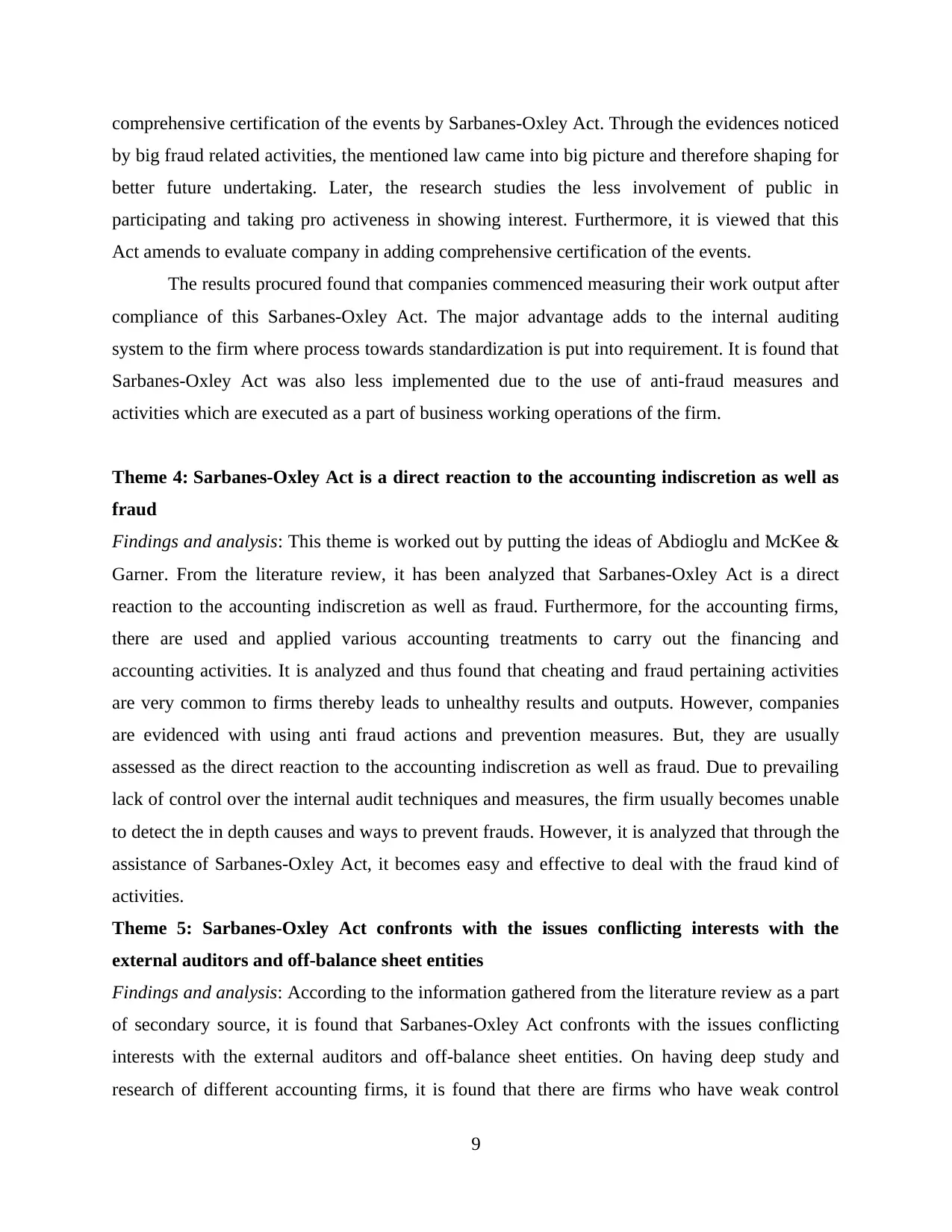
comprehensive certification of the events by Sarbanes-Oxley Act. Through the evidences noticed
by big fraud related activities, the mentioned law came into big picture and therefore shaping for
better future undertaking. Later, the research studies the less involvement of public in
participating and taking pro activeness in showing interest. Furthermore, it is viewed that this
Act amends to evaluate company in adding comprehensive certification of the events.
The results procured found that companies commenced measuring their work output after
compliance of this Sarbanes-Oxley Act. The major advantage adds to the internal auditing
system to the firm where process towards standardization is put into requirement. It is found that
Sarbanes-Oxley Act was also less implemented due to the use of anti-fraud measures and
activities which are executed as a part of business working operations of the firm.
Theme 4: Sarbanes-Oxley Act is a direct reaction to the accounting indiscretion as well as
fraud
Findings and analysis: This theme is worked out by putting the ideas of Abdioglu and McKee &
Garner. From the literature review, it has been analyzed that Sarbanes-Oxley Act is a direct
reaction to the accounting indiscretion as well as fraud. Furthermore, for the accounting firms,
there are used and applied various accounting treatments to carry out the financing and
accounting activities. It is analyzed and thus found that cheating and fraud pertaining activities
are very common to firms thereby leads to unhealthy results and outputs. However, companies
are evidenced with using anti fraud actions and prevention measures. But, they are usually
assessed as the direct reaction to the accounting indiscretion as well as fraud. Due to prevailing
lack of control over the internal audit techniques and measures, the firm usually becomes unable
to detect the in depth causes and ways to prevent frauds. However, it is analyzed that through the
assistance of Sarbanes-Oxley Act, it becomes easy and effective to deal with the fraud kind of
activities.
Theme 5: Sarbanes-Oxley Act confronts with the issues conflicting interests with the
external auditors and off-balance sheet entities
Findings and analysis: According to the information gathered from the literature review as a part
of secondary source, it is found that Sarbanes-Oxley Act confronts with the issues conflicting
interests with the external auditors and off-balance sheet entities. On having deep study and
research of different accounting firms, it is found that there are firms who have weak control
9
by big fraud related activities, the mentioned law came into big picture and therefore shaping for
better future undertaking. Later, the research studies the less involvement of public in
participating and taking pro activeness in showing interest. Furthermore, it is viewed that this
Act amends to evaluate company in adding comprehensive certification of the events.
The results procured found that companies commenced measuring their work output after
compliance of this Sarbanes-Oxley Act. The major advantage adds to the internal auditing
system to the firm where process towards standardization is put into requirement. It is found that
Sarbanes-Oxley Act was also less implemented due to the use of anti-fraud measures and
activities which are executed as a part of business working operations of the firm.
Theme 4: Sarbanes-Oxley Act is a direct reaction to the accounting indiscretion as well as
fraud
Findings and analysis: This theme is worked out by putting the ideas of Abdioglu and McKee &
Garner. From the literature review, it has been analyzed that Sarbanes-Oxley Act is a direct
reaction to the accounting indiscretion as well as fraud. Furthermore, for the accounting firms,
there are used and applied various accounting treatments to carry out the financing and
accounting activities. It is analyzed and thus found that cheating and fraud pertaining activities
are very common to firms thereby leads to unhealthy results and outputs. However, companies
are evidenced with using anti fraud actions and prevention measures. But, they are usually
assessed as the direct reaction to the accounting indiscretion as well as fraud. Due to prevailing
lack of control over the internal audit techniques and measures, the firm usually becomes unable
to detect the in depth causes and ways to prevent frauds. However, it is analyzed that through the
assistance of Sarbanes-Oxley Act, it becomes easy and effective to deal with the fraud kind of
activities.
Theme 5: Sarbanes-Oxley Act confronts with the issues conflicting interests with the
external auditors and off-balance sheet entities
Findings and analysis: According to the information gathered from the literature review as a part
of secondary source, it is found that Sarbanes-Oxley Act confronts with the issues conflicting
interests with the external auditors and off-balance sheet entities. On having deep study and
research of different accounting firms, it is found that there are firms who have weak control
9
⊘ This is a preview!⊘
Do you want full access?
Subscribe today to unlock all pages.

Trusted by 1+ million students worldwide
1 out of 24
Related Documents
Your All-in-One AI-Powered Toolkit for Academic Success.
+13062052269
info@desklib.com
Available 24*7 on WhatsApp / Email
![[object Object]](/_next/static/media/star-bottom.7253800d.svg)
Unlock your academic potential
Copyright © 2020–2025 A2Z Services. All Rights Reserved. Developed and managed by ZUCOL.





